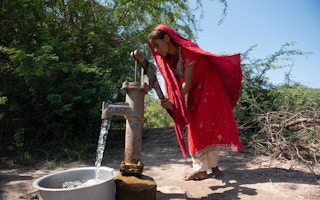The existence of “women’s issues” reflects the simple fact that we live in a man’s world. Over the course of centuries, research and policies focused on men became the default, whereas initiatives that account for women are “women-centered.”
But if men are treated as the default, virtually no aspect of women’s lives ends up being built or optimized for them. Research that excludes women is not simply “gender-neutral” – it is “incomplete.”
The consequences can be deadly. For example, women are 73 per cent more likely to be injured, and 17 per cent more likely to die, in vehicle crashes than men.
One reason for this is that the crash-test dummies used in vehicle-safety trials are designed to mimic the body of an average man. “Female” dummies were not even developed until last year, and regulators still do not require that they be included in vehicle-safety research.
Personal protective equipment, like that used by health-care workers, is also optimised for male bodies, with dimensions staying the same even as items are scaled down for women users. In a 2020 survey of British health-care workers, 44.7 per cent of women found PPE overalls ill-fitting, compared to just 15.3 per cent of men. In a recent survey in Canada, more than 80 per cent of women respondents reported issues with PPE.
Similarly, the “unisex” body armor used by police officers is designed for men, leaving women both uncomfortable and potentially more vulnerable to attack, especially around the armpit and neck. In the United Kingdom, where 50,000 women now serve as police officers, women-specific body armour was not introduced until this year.
While women are no longer excluded from clinical-drug trials, they continue to be underrepresented, particularly in the trials’ early phases. As a result, women still face a higher risk of adverse side effects from medication, not least because recommended doses are not optimised for women.
An analysis of studies in which women were given the same drug dosage as men showed that, in more than 90 per cent of cases, women experienced stronger side effects and more adverse reactions.
That analysis arose from the observation that women taking Ambien, a sleep medication, were experiencing severe side effects, including a higher rate of traffic accidents the morning after.
As it turned out, researchers found, the recommended dose produced much higher blood concentrations and drug-elimination times in women than in men. The US Food and Drug Administration now recommends that women receive half the “standard” dose.
Making matters worse, when it comes to health issues that primarily affect women, research tends not to be funded at all. In nearly 75 per cent of cases where a disease primarily affects one sex, the pattern favours men: “men’s diseases” are overfunded, and “women’s diseases” are underfunded.
Women’s needs also take a backseat to men’s when it comes to tackling sexual violence. Because women are overwhelmingly the victims of such crimes, preventing sexual violence is treated entirely as a “women’s issue” – one that has no consequences for men, even though they comprise the majority of perpetrators.
Policies are so focused on the victims – for example, improving outdoor lighting, establishing helplines, and creating “safe spaces” – that the source of the violence is never addressed.
Likewise, health-related data have been collected primarily from men, which poses serious risks as artificial intelligence trained on such data is applied in health care. For example, if a man reports pain in his left arm and back, a medical app – trained on data establishing cardiovascular disease as a predominantly male issue – will recommend that he seek help for a potential heart attack.
That same app might suggest that a woman is experiencing depression and thus does not need urgent care, even though women are hardly immune to heart attacks.
AI has the potential to harm women in other ways, too. In 2015, Amazon scrapped its AI recruiting tool for exhibiting bias against women. Having “learned” to assess applications by observing patterns in resumes submitted over the previous decade – resumes that had come overwhelmingly from men – the computer model rated male candidates more highly.
This should not be surprising, given women account for only 12 per cent of AI researchers and 6 per cent of software developers. Several other companies that continue to use AI software for recruitment do not monitor it for bias.
Despite considerable evidence showing that advances toward gender equality play an important role in driving economic progress, analysis focusing solely on macro aspects of growth disregards gender. Ignoring the fact that government spending, taxation, and monetary policy have different consequences for men and women can lead to flawed economic assessments, undermining the effectiveness of policies and the accuracy of forecasts.
For example, women’s unpaid labour as primary caregivers is unaccounted for in macroeconomic policy. Tasks like cooking, cleaning, fetching water, and caring for children and the elderly have substantial economic value, accounting for between 10-60 per cent of GDP.
As a result of gender-blind analysis, women are overworked and underpaid. Increasing the share of women in the workforce needs to be accompanied by policies that reduce and redistribute this unpaid labour.
Consider the debate over India’s economic prospects. With India having recently overtaken China in population, some analysts predict that it will also surpass China in economic growth. But, as Ashwini Deshpande and Akshi Chawla explain, this works only if the population increase is reflected the workforce, and in India, low female labour-force participation limits the effect.
Gender plays a crucial role in countless other policy areas, including the single biggest challenge of our time: climate change. Like most of the other issues addressed by the Sustainable Development Goals, the effects of global warming, including climate-related disasters, disproportionately affect women.
When half the global population is treated as an afterthought, research is less accurate, policy is less effective, and human welfare is diminished. That will not change until accounting explicitly for women becomes the norm in every sphere of research, product design, tech, and policy.
Navika Mehta is economist editor at the International Economic Association, advocating for greater gender equality and representation in the field of economics through the Amplifying Women’s Voices project of the IEA Women in Economics Initiative.
Copyright: Project Syndicate, 2024
www.project-syndicate.org


















